HUE
We flew on Vietnam Airlines from Hanoi to Hue (pronounced Hway). It was after dark when we arrived, and we were met at the airport by our guide, Lani, and our driver. We made a short drive from the airport to the Century Riverside Hotel which would be home for our few short days in Hue, and our first night there was spent quietly at the hotel.
We immediately liked Hue. Compared to Hanoi, it is a small city (300,000), and it is reportedly a safe city with very low crime. It relies on the tourist dollar, and it warmly welcomes tourists.
Hue markets itself as the intellectual, cultural, and spiritual heart of Vietnam. Hue was also the political capital of Vietnam from 1802 to 1945 as Vietnam was ruled by 13 emperors of the Nguyen dynasty – the last Vietnamese dynasty. In Hue, one can visit the remnants of that dynasty – including the Citadel and royal tombs – as well as three local pagodas.
On our third day we again had heavy fog in the morning. We were approaching Gibralter and maneuvering our way through a lot of anchored and anchoring ships. Thank goodness for our radar!
The marinas in Gibralter are known for being unfriendly to cruising boats, and they almost always send them away. We went to Alcaidesa Marina less than 100 yards from the border with Gibralter. Alcaidesa Marina is in the town of La Linea, Spain.
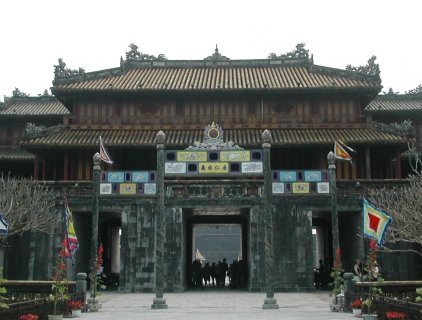
Outer Gate in to Citadel
The Perfume River – Song Huong – runs through the middle of Hue, and it is a nice way to get an overview of the city. We took a ‘dragon boat’ down the river to see the sights from the water. The dragon boat is a colorfully painted old wooden boat about 40 feet in length and no more than 12 feet wide. It is home to the man and woman that run it during the day. Although the couple on this boat did not speak any English, they were still fairly communicative, and Lani interpreted for us when necessary. We, and our guide, were the only passengers.
As we cruised downriver, the woman unpacked lots of local crafts she wanted to sell. When Lani explained that we lived on a boat the size of theirs, she understood that we could not buy much. We did, however, buy a few things from her.
As we went further downriver, all dragon boats were being stopped by the police. We asked why, and we were told that sometimes they just asked to see operator permits, and sometimes they shook down the boats for money. This trip cost the woman 20,000 VND (approximately $1.25 USD) to pass. Such open graft!
We got off the boat at the Thien Mu Pagoda which was built in 1601. This pagoda is a functioning monastery for Buddhist monks, and it is beautifully maintained by its resident monks. Young boys are sent here by their families. Some leave after a few years, but most remain monks for the rest of their lives. There were monks of every age and size roaming around here, and we enjoyed seeing them go about their daily activities.. This is also the infamous home pagoda of Thich Quang Duc whom publicly burned himself to death in 1963 to protest the policies of President Ngo Dinh Diem. There is a tribute to Ngo at the pagoda.
We also went to the Dieu De National Pagoda which was built in the nineteenth century and was once under the direct patronage of the emperor. This pagoda was also a stronghold of Buddhist and student opposition to the South Vietnamese government and war. However, we were getting a bit burned out on temples and pagodas. We had seen so many that we were on overload, and we wanted to do something other than visit pagodas. So we went off to the local market.
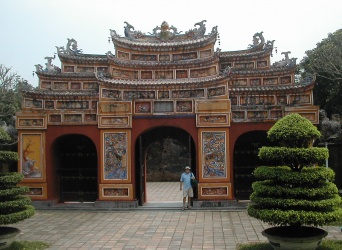
Inner Gate in Citadel

Dong Ba Market
Hue has a great market – the Dong Ba Market. Although one can buy more than just produce there – clothing, electronics, housewares – we were particularly impressed with the appearance of the produce. We bought a few fruits to take back to the hotel with us, and they were very good.
Then we went to visit Hue’s primary drawing card – the Citadel, or Kinh Thanh. This is a moated imperial city with a design remarkably similar to China’s Forbidden City. Its walls are 20 feet tall and run for 1 ½ miles in each direction enclosing 2.25 square miles. Emperor Gia Long started construction on Vietnam’s Citadel in 1804, and it took decades to finish.
The Citadel is a city within a city within a city. The core is the Forbidden Purple City – Tu Cam Thanh – which was the site of the emperors’ private lives. Surrounding the Forbidden Purple City is the Imperial Enclosure which was the site of the emperors’ official functions. Surrounding the Imperial Enclosure is the majority of the Citadel’s land.
The Citadel was heavily bombed and badly damaged by the Americans during the Tet Offensive in 1968. Large craters remain where B-52 bombs dropped, and large parts of buildings are gone. Many of the remaining buildings are peppered with bullet holes. Fortunately this historic treasure was not totally lost.
Although we thought we were overloaded with temples and pagodas, the temple at the Citadel captivated both of us. Our guide knows her local history, and we learned a lot about this era in Vietnam by what and who was and was not in the imperial temple. One of the more interesting and eccentric emperors we learned about in the temple was Tu Duc, so we decided to visit his royal tomb, and we weren’t disappointed.
Tu Duc’s tomb is five miles out of town in Duong Xuan village. Tu Duc designed this tomb so that he could enjoy it while living as well as have it serve as his tomb after death. The tomb was built over three years – 1864 to 1867 – using half of the local population including many children.
The tomb is comprised of more than forty buildings spread over 25 nicely wooded acres with artificial water features added. Upon entering the grounds, one notices the pavilion on the lake to the right. To the left is the entrance to Hoa Khiem Palace where Tu Duc worked while here. This palace became a temple after his death.
Beyond the palace/temple is the actual tomb. However, to get to the tomb, one must pass a stone honor guard of man and beast. Then one reaches the Stele Pavilion with its twenty ton tablet. The tablet is ironically inscribed with verse composed by Tu Duc speaking to ‘modesty’. (This is the only modest thing about this tomb.) Beyond the pavilion are two stone pillars through which one passes to ascend to the actual burial tomb. And inside the tomb is a pair of grey trousers. Tu Duc is not buried here.
Tu Duc’s actual burial site is unknown. Apparently the Vietnamese had great concerns about grave robbing because those involved with his burial were killed immediately afterwards so that they could not reveal its location. Although there are other royal tombs in and around Hue, they too are not actual burial sites. The actual burial site of only one emperor (one of fourteen) is known, and he is buried more than 20 feet deep.
We really enjoyed walking around town in Hue. The local food was excellent, we listened to some local music, and we learned about Vietnamese embroidery at a local gallery. We saw some nice embroidery outside of Hanoi, but it was nothing like what we saw in Hue. This was fine art. We badly wanted a piece to keep on board Passage, but we could not find one small enough. We would have had one made if we had more time in Hue, but this was a quick stop for us, and we had to move on. But we will always remember the beauty of the work done by central Vietnamese women. We will also fondly remember Hue.
But it was already time to move on again. On to Saigon…
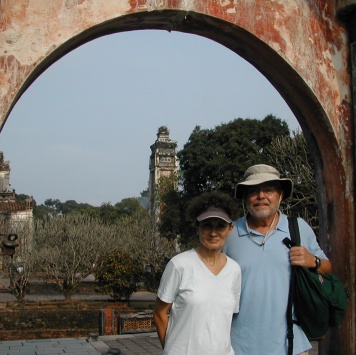
At Tu Duc’s tomb
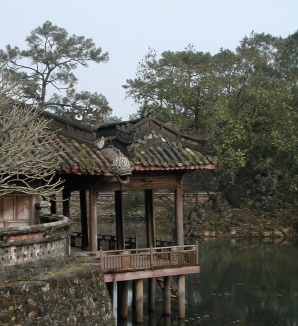
Pavilion and Lake
Follow us to Saigon or jump ahead to the Mekong Delta and River
Or skip the rest of Vietnam and jump ahead to Cambodia.
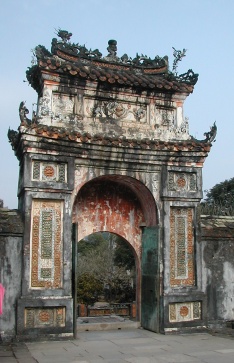
Gate leading to Tu Duc’s tomb